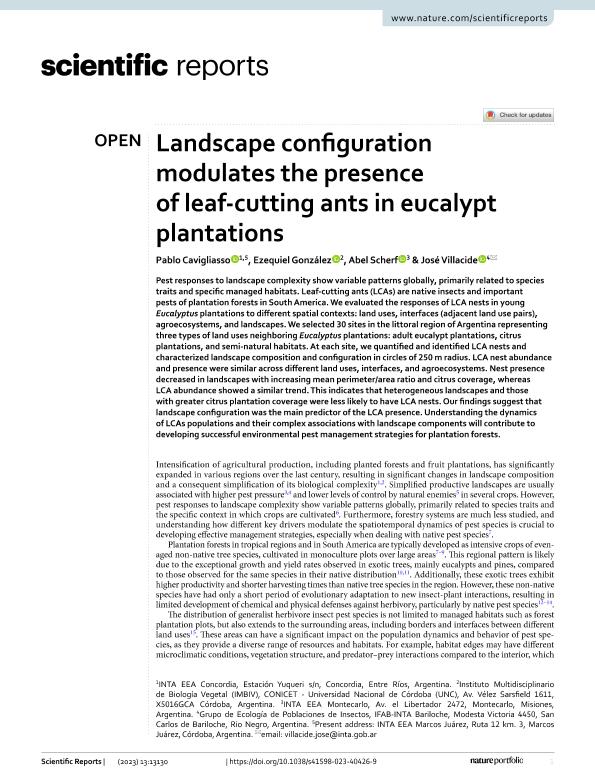Mostrar el registro sencillo del ítem
dc.contributor.author
Cavigliasso, Pablo

dc.contributor.author
González, Ezequiel

dc.contributor.author
Scherf, Abel
dc.contributor.author
Villacide, José
dc.date.available
2023-12-28T13:53:42Z
dc.date.issued
2023-08-12
dc.identifier.citation
Cavigliasso, Pablo; González, Ezequiel; Scherf, Abel; Villacide, José; Landscape configuration modulates the presence of leaf-cutting ants in eucalypt plantations; Nature Research; Scientific Reports; 13; 1; 12-8-2023; 1-9
dc.identifier.uri
http://hdl.handle.net/11336/221801
dc.description.abstract
Pest responses to landscape complexity show variable patterns globally, primarily related to species traits and specific managed habitats. Leaf-cutting ants (LCAs) are native insects and important pests of plantation forests in South America. We evaluated the responses of LCA nests in young Eucalyptus plantations to different spatial contexts: land uses, interfaces (adjacent land use pairs), agroecosystems, and landscapes. We selected 30 sites in the littoral region of Argentina representing three types of land uses neighboring Eucalyptus plantations: adult eucalypt plantations, citrus plantations, and semi-natural habitats. At each site, we quantified and identified LCA nests and characterized landscape composition and configuration in circles of 250 m radius. LCA nest abundance and presence were similar across different land uses, interfaces, and agroecosystems. Nest presence decreased in landscapes with increasing mean perimeter/area ratio and citrus coverage, whereas LCA abundance showed a similar trend. This indicates that heterogeneous landscapes and those with greater citrus plantation coverage were less likely to have LCA nests. Our findings suggest that landscape configuration was the main predictor of the LCA presence. Understanding the dynamics of LCAs populations and their complex associations with landscape components will contribute to developing successful environmental pest management strategies for plantation forests.
dc.format
application/pdf
dc.language.iso
eng
dc.publisher
Nature Research
dc.rights
info:eu-repo/semantics/openAccess
dc.rights.uri
https://creativecommons.org/licenses/by-nc-sa/2.5/ar/
dc.subject
ACROMYRMEX
dc.subject
PLANTATION FORESTS
dc.subject
LANDSCAPE HETEROGENEITY
dc.subject
ENVIRONMENTAL PEST MANAGEMENT
dc.subject.classification
Otras Ciencias Agrícolas

dc.subject.classification
Otras Ciencias Agrícolas

dc.subject.classification
CIENCIAS AGRÍCOLAS

dc.title
Landscape configuration modulates the presence of leaf-cutting ants in eucalypt plantations
dc.type
info:eu-repo/semantics/article
dc.type
info:ar-repo/semantics/artículo
dc.type
info:eu-repo/semantics/publishedVersion
dc.date.updated
2023-12-13T11:22:37Z
dc.identifier.eissn
2045-2322
dc.journal.volume
13
dc.journal.number
1
dc.journal.pagination
1-9
dc.journal.pais
Estados Unidos

dc.description.fil
Fil: Cavigliasso, Pablo. Instituto Nacional de Tecnologia Agropecuaria Eea Concordia; Argentina. Instituto Nacional de Tecnología Agropecuaria. Centro Regional Buenos Aires; Argentina
dc.description.fil
Fil: González, Ezequiel. Consejo Nacional de Investigaciones Científicas y Técnicas. Centro Científico Tecnológico Conicet - Córdoba. Instituto Multidisciplinario de Biología Vegetal. Universidad Nacional de Córdoba. Facultad de Ciencias Exactas Físicas y Naturales. Instituto Multidisciplinario de Biología Vegetal; Argentina
dc.description.fil
Fil: Scherf, Abel. Instituto Nacional de Tecnologia Agropecuaria Eea Montecarlo; Argentina
dc.description.fil
Fil: Villacide, José. Instituto Nacional de Tecnologia Agropecuaria Bariloche; Argentina
dc.journal.title
Scientific Reports
dc.relation.alternativeid
info:eu-repo/semantics/altIdentifier/doi/http://dx.doi.org/10.1038/s41598-023-40426-9
dc.relation.alternativeid
info:eu-repo/semantics/altIdentifier/url/https://www.nature.com/articles/s41598-023-40426-9
Archivos asociados
